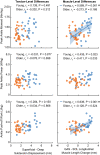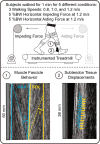Age-related changes to triceps surae muscle-subtendon interaction dynamics during walking
- PMID: 34711893
- PMCID: PMC8553842
- DOI: 10.1038/s41598-021-00451-y
Age-related changes to triceps surae muscle-subtendon interaction dynamics during walking
Abstract
Push-off intensity is largely governed by the forces generated by the triceps surae (TS) muscles (gastrocnemius-GAS, soleus-SOL). During walking, the TS muscles undergo different fascicle kinematics and contribute differently to biomechanical subtasks. These differences may be facilitated by the Achilles tendon (AT), which is comprised of subtendons that originate from the TS muscles. We and others have revealed non-uniform displacement patterns within the AT-evidence for sliding between subtendons that may facilitate independent muscle actuation. However, in older adults, we have observed more uniform AT tissue displacements that correlate with reduced push-off intensity. Here, we employed dual-probe ultrasound imaging to investigate TS muscle length change heterogeneity (GAS-SOL) as a determinant of reduced push-off intensity in older adults. Compared to young, older adults walked with more uniform AT tissue displacements and reduced TS muscle length change heterogeneity. These muscle-level differences appeared to negatively impact push-off intensity-evidenced by between-group differences in the extent to which TS muscle length change heterogeneity correlates with mechanical output across walking tasks. Our findings suggest that the capacity for sliding between subtendons may facilitate independent TS muscle actuation in young adults but may restrict that actuation in older adults, likely contributing to reduced push-off intensity.
© 2021. The Author(s).
Conflict of interest statement
The authors declare no competing interests.
Figures





References
-
- Zajac FE. Muscle and tendon: Properties, models, scaling, and application to biomechanics and motor control. Crit. Rev. Biomed. Eng. 1989;17:359–411. - PubMed
Publication types
MeSH terms
Grants and funding
LinkOut - more resources
Full Text Sources
Medical

